|
27th to 30th September:
A few days in the Kingdom of Fife
This blog describes a weekend break (sans John) based in the beautiful,
historic Fife town of St Andrews. It was blessed with plenty of bright weather,
although it was quite cold and windy at times.
St Andrews
On Friday morning I enjoyed a stroll along the West Sands beach, but it was disappointing in that the tide was very low and the few birds I
could see were very distant and every other walker had a dog. The return
journey was along the West Sands Road that runs parallel to the Jubilee golf
course. I was pleased to find a few photo-opportunities there, starting with a
handsome Stonechat standing proudly in the bright Autumn sunshine. I snapped
the hoverfly, Syrphus Ribesii as it supped the nectar of flowers of Hedge
Mustard. Next I was initially startled by a pair of Skylarks that seemed to be
indulging in a bit of late season courting. Once they had settled, I was able
to get some satisfying shots. There were also some very mobile and noisy
Goldfinches in the bushes along the course. Their plumages were not at their
best, probably as they were moulting.
| Stonechat |
Hoverfly - Syrphus ribesii |
Skylark |
Goldfinch |
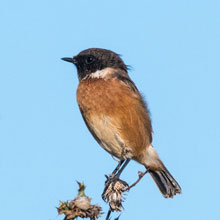 |
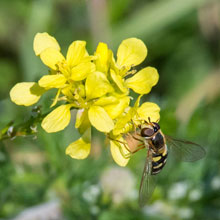 |
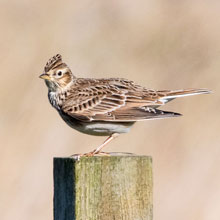 |
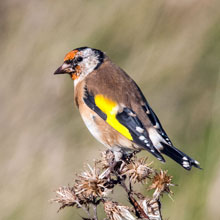 |
In one fenced-off area between the road and the sand dunes and beach, next
to the 9th and 10th holes of the Jubilee Course, there were a dozen or so
grazing Hebridean Sheep As I attempted to get that definitive sheep shot, a Small White butterfly
fluttered past and also settled on the yellow Hedge Mustard flowers. Nearby, a
Starling was calling from the top of a fence post and below it a Carrion Crow
was nibbling on, well, carrion, probably a big worm.
| Hebridean Sheep |
Small White Butterfly |
Starling |
Carrion Crow |
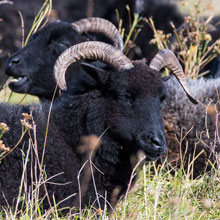 |
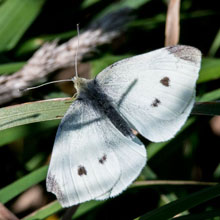 |
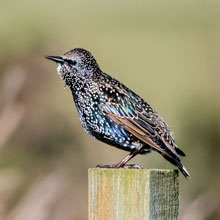 |
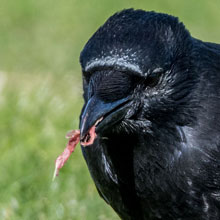 |
At the car a White Wagtail and a Black-headed Gull were hanging about
waiting for some scraps of food from the many parked cars. But that was all I
saw in my short walk. However, later in the day I had a stroll around the
harbour area and East Sands beach. Lively House Sparrows were frolicking in the
long grass, as, offshore, I spotted that a Cormorant had caught a fish,
probably a Rockling.
| White Wagtail |
Black - headed Gull |
House Sparrow |
Cormorant |
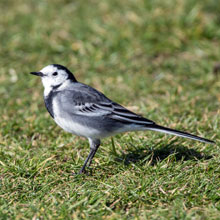 |
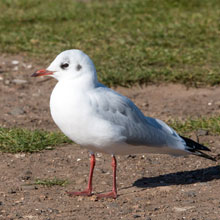 |
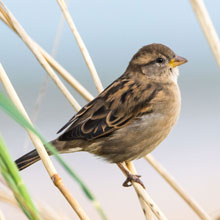 |
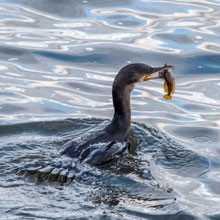 |
My next sighting was rather weird. I heard a man shouting followed by the
sight of a barefooted bride running along the top of the harbour wall. Then I
noticed that the man who had been shouting was operating a drone. I can only
guess that I had been watching him using the drone to take aerial pictures of
the bride. At several places along the harbour there were violet and yellow
Seaside Daisies, a naturalised plant, originating from North American coasts.
Along the breakwater there were several Ringed Plovers, which may have been a
family of 2 adults with 4 or 5 juveniles. My last sighting was of a very
familiar bird, a Rock Pipit, as it meandered and pecked its way along the
harbour road.
| Brave Bride |
Seaside Daisy |
Ringed Plover |
Rock Pipit |
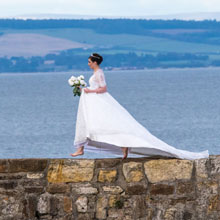 |
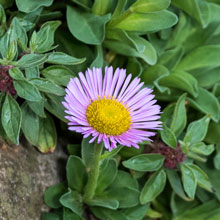 |
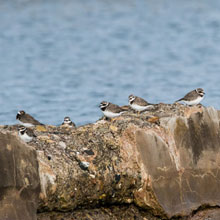 |
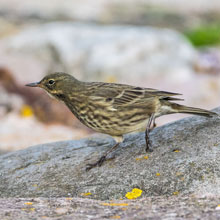 |
Crail:
The following day I found myself exploring the ancient coastal town of
Crail. I walked along the part of the Fife Coastal Path that
passes along the south of the town. My first capture was of a beautiful Painted
Lady butterfly as it sheltered from the stiff breeze. Along the sides of the
path I spotted several pretty wildflowers. First of these were Sun Surge and
Common Fumitory. The latter has been used in the past to treat conjunctivitis
and skin diseases, and also to cleanse the kidneys, although we now know it is
actually poisonous -so don’t try it! A Kestrel paid me a visit as I
photographed the flowers. It hovered several times as it passed, allowing my
the opportunity to get some pictures.
| Painted Lady Butterfly |
Sun Spurge |
Common Fumitory |
Kestrel |
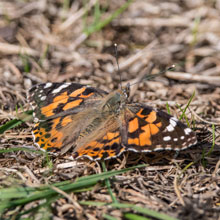 |
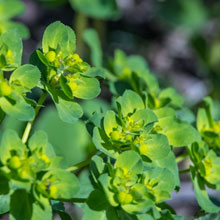 |
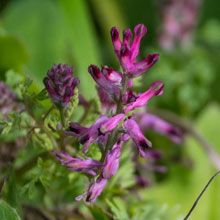 |
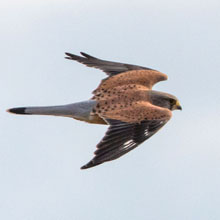 |
Every 5 minutes, 2 or 3 Gannets swept by. The Bass Rock, home to hundreds of
Gannets, is on the other side of the Firth of Forth, a short trip for such
powerful birds. The picture below is of a first cycle juvenile, one of the many
I saw, each earning its wings just as its first summer has come to an end. I
was being carefully watched from the Rocky shore by a Wheater that will soon be
flying south to winter in Central Africa. Also cautiously tracking me was a
Curlew. As I moved slowly along the shore it kept a safe distance between us.
Just before I left the path I came across a wee Dipper hiding behind large
rocks at the mouth of a burn (See “Pictures of the Week”, below). The dipping
and bobbing movements, from which it gets its name, make it easier to spot -
and a large focal length lens also helps! The final shot was of an eye-catching
flower, Fox and Cubs. It’s not a plant you’d want in your garden though, as
once established, is very difficult to prevent it from spreading across the
whole garden.
| 1st Cycle Gannet |
Wheatear |
Curlew |
Fox And Cubs |
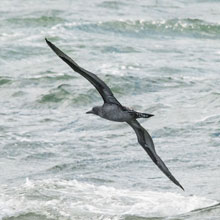 |
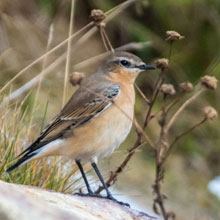 |
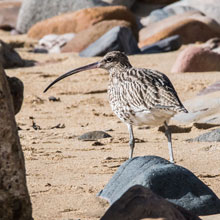 |
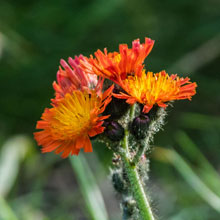 |
RSPB Loch Leven:
On my way home I dropped into the fine RSPB reserve at the south end of Loch
Leven. It was another butterfly that started my set of pictures. It was a wee
bit chilly and I think the Red Admiral was gathering heat from sun. After this
I visited the three hides only to be disappointed by the scarcity of birds. I
was just on the verge of leaving when I heard in the distance the familiar and
very welcome sound of geese. I immediately doubled back and rushed into the
nearest hide where I witnessed the truly awesome sight, and sounds, of the
arrival of at least 1000 Pink-footed Geese (See “Pictures of the Week”, below).
They had recently arrived from Iceland and Greenland. Up to 10,000 were
expected by the end of October. Just as I took shots of the geese, a Kestrel
passed overhead, a pair of Whooper Swans, recently arrived from Iceland, flew
along the banks of the Loch, and …
| Red Admiral Butterfly |
Pink - footed Goose |
Kestrel |
Whooper Swan |
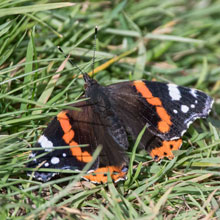 |
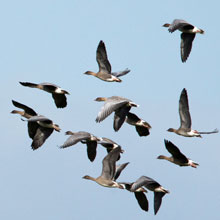 |
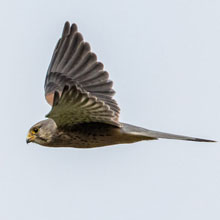 |
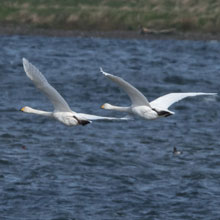 |
… a Grey Heron flew across the front of the hide. And still the Geese poured
in and landed about 300m away from the hide. As I watched them I noticed a few
agitated Curlews only 50m from the hide. Maybe the geese unsettled them. After
30 minutes I left more satisfied than I had been earlier. A flying female
Mallard signalled the end of my quick visit.
| Pink - footed Goose |
Grey Heron |
Curlew |
Female Mallard |
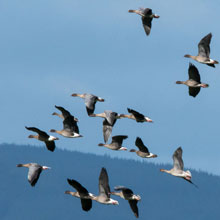 |
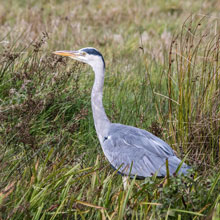 |
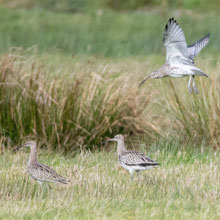 |
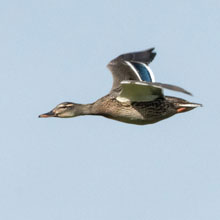 |
My brief but very enjoyable visit to Fife was rounded off with a cup of tea
and a fruit scone served up in the very welcoming Reserve cafe.
Pictures of the Week;
| House Sparrow |
Dipper |
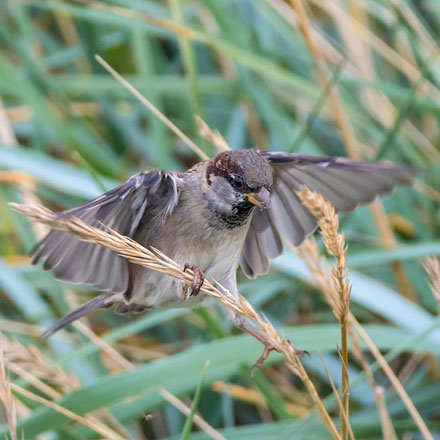 |
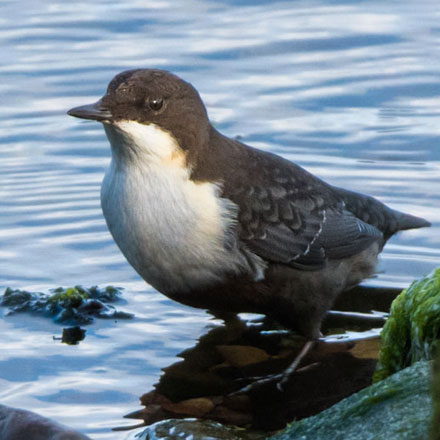 |
| Pink - footed Goose |
Grey Heron |
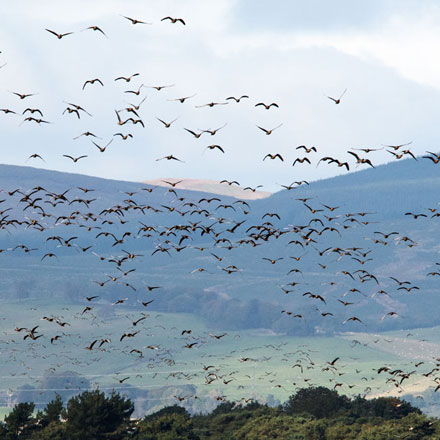 |
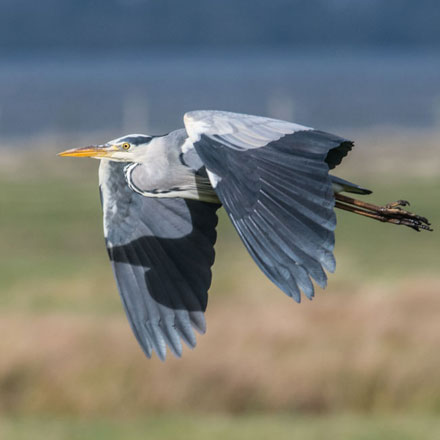 |
23rd September 2018: Balgray Reservoir
Reports of a Grey Phalarope treading the shallows of Balgray Reservoir
drew us to the the southern outskirts of Glasgow on a very bright but chilly
Sunday afternoon. It was our first visit there but we found the site very
easily as it is a straightforward route from East Kilbride. On parking the car
we set off down the wide asphalt path which was lined with various berry-covered
bushes. We saw red berries of Hawthorn and Wild Rose hips and also the very
cute red berries of the climbing wildflower, Bittersweet. The leaves of
Bittersweet have a bitter, then sweet taste, hence the name (don’t do it though
as they are poisonous when eaten in large amounts!). We also came across an
Elder tree lusciously loaded with deep purple berries
(which are thought by some to be good for you.)
| Common Hawthorn Fruit |
Wild Rose Fruit |
Bitersweet Fruit |
Elderberry |
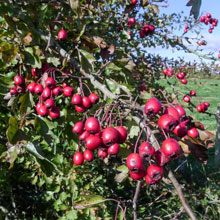 |
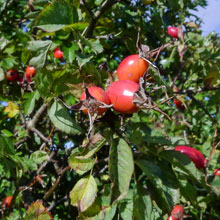 |
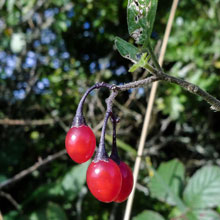 |
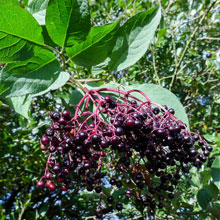 |
Along the verges of the path,
several patches of the beautiful violet and
yellow Michaelmas Daisies stood above the long grass. I stood over one
such
plant with my trusty LUMIX LX5 (which I use for macros) and had
soon photographed a trio of different species of hoverfly: the
aptly named Common
Banded Hoverfly, syrphus_ribesii, The Footballer (due to its vertical
stripes
being like a football strip) helophilus_pendulus (Greek for"dangling
marsh-lover") and the less attractive, bee-like, eristalis_arbustorum.
Close by on a Bramble leaf, I caught picture of the Bluebottle,
calliphora_vicina, now, late in the season, more grey than blue.
| Hoverfly - Syrphus ribesii |
Hoverfly - Helophilus pendulus |
Hoverfly - Eristalis arbustorum |
Fly - Calliphora vicina |
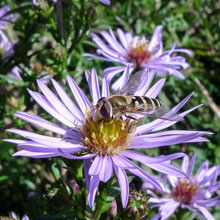 |
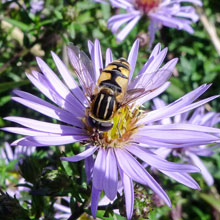 |
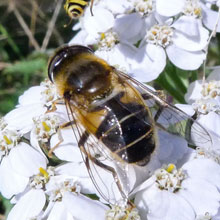 |
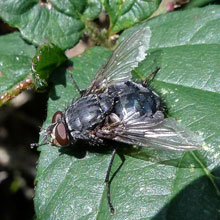 |
We had gathered all of those sightings and we hadn’t even reached the
reservoir, but when we did our hearts fell a bit as it had very little water in
it. A few people were out in the middle of the reservoir basin digging for
something or other. We found out what that was as we reached a concrete quay upon which
were a load of freshwater Swan Mussels. As we scanned the basin we could see
birds, but they were over 100m away. A Little Grebe swam to the edge of a pool,
still 50 m away. However as we moved along the south side of the reservoir we
came upon a pair of relatively close Bar-tailed Godwits probing the shallows
for invertebrates.
No Phalaropes though. We pressed on past a dabbling female Teal and cautious
Black-headed Gull. Across the basin, the causeway and tower were fully exposed by
the lack of water. John is due an apology as I thought he was seeing things
when he maintained that a bird flapping its wings had been sitting near the
base of the tower, not far from a Little Grebe. I thought it was waves lapping
over a rock, but inspection of the photos later clearly showed that there was a
bird, probably a Common Sandpiper, tucked between the chunky boulders.
At the south end of the reservoir, where the Phalarope had been seen, it was
clear “the bird had flown”. Still, we did see nice but less rare birds such as
Teal, Tufted Ducks, Meadow Pipits and, one of my favourites, a Grey Wagtail.
| Teal |
Female Tufted Duck |
Meadow Pipit |
Grey Wagtail |
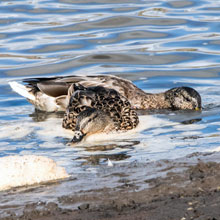 |
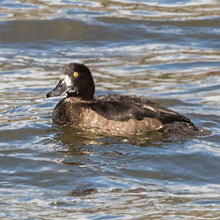 |
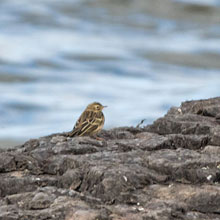 |
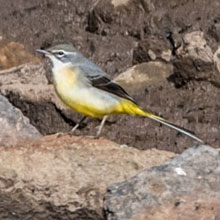 |
A Great Crested Grebe got within camera range and we had a fly past of
Lapwings that had been resting in a neighbouring field before being spooked by
some unseen hazard. We headed back up the path, determined to make the most of our
time there. A Peacock butterfly fluttered past our heads onto some Michaelmas
Daisies, and then, out of nowhere, a Kestrel appeared hovering some 10m above
us, so close I had to zoom-in my lens. It was a pity the Kestrel was facing the
wrong way!
| Great Crested Grebe |
Lapwing |
Peacock Butterfly |
Kestrel |
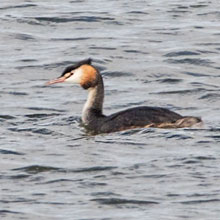 |
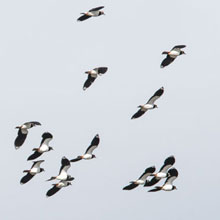 |
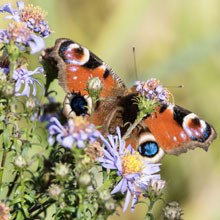 |
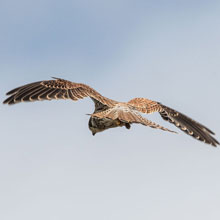 |
The most common birds we saw were probably Herring Gulls. Maybe they were
picking off any invertebrates or even fish, frogs and newts exposed by the low
water level. As we walked across a footbridge I noticed a Monkey Flower
flourishing at the edges of the stream below. In a field near the car park we
relocated the Lapwings we had seen earlier. They seemed calm enough lodging
with the cattle.
| Herring Gull |
Monkey Flower |
Lapwing |
Cattle |
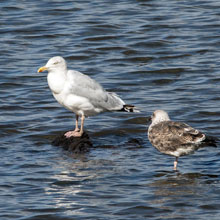 |
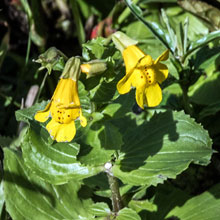 |
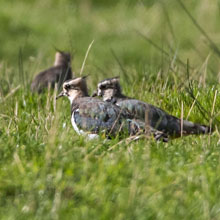 |
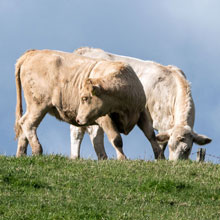 |
In the last 50m of our walk I managed to creep up on an exquisite Painted
Lady butterfly as it fed on, you’ve guessed it, Michaelmas Daisies. Out in the
muddy basin I noticed small waders scurrying around. They were Ringed Plover
and Dunlin. As they were quite far out, my shots were, as they say on social
media in such circumstances, merely record shots. Our final two flowers of the
day were of a Marsh Woundwort hiding in the long grass, and the eye catching
Red Clover on the banks of the Reservoir.
| Painted Lady Butterfly |
Dunlin / Ringed Plover |
Marsh Woundwort |
Red Clover |
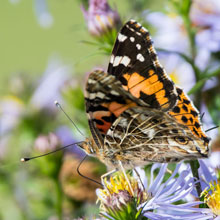 |
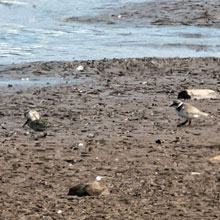 |
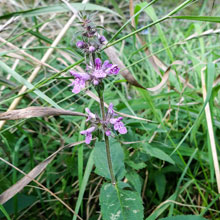 |
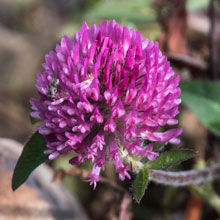 |
Our final two birds of the visit were probably my favourite shots - a cheeky
wee Robin checking us out as it sat on a black post, and a female Reed Bunting
that John spotted as I was reversing out of the car park. Because I was
driving, I passed the camera to John who expertly executed the shot. (see
“Pictures of the Week”, below). As per usual we finished the day with a cup of strong tea, this time
accompanied by the same delicacy as last week, lemon cream muffin. We agreed
that it had been a pleasant trip with lots to interest us. It was just a pity
we dipped out on the Grey Phalarope.
Pictures of the Week:
| Peacock Butterfly |
Robin |
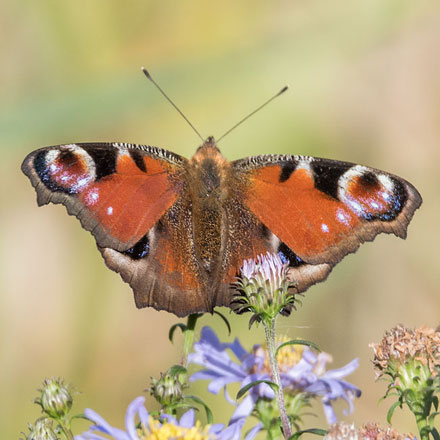 |
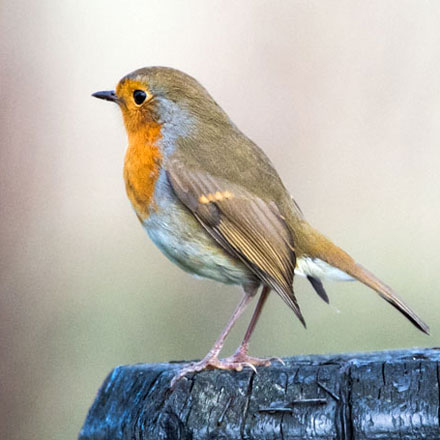 |
| Painted Lady Butterfly |
Female Reed Bunting |
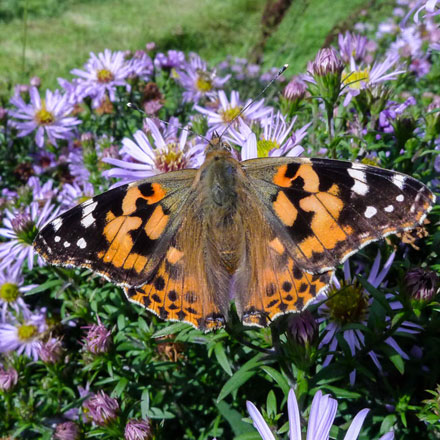 |
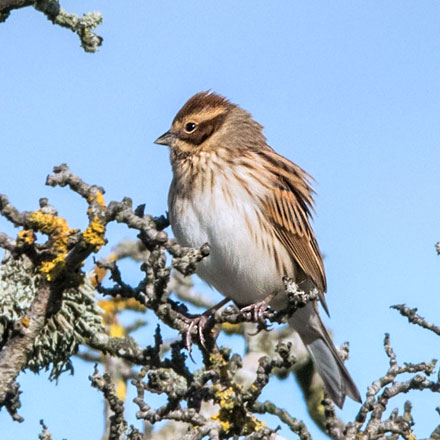 |
16th September 2018 : Musselburgh
We chose to travel east to Musselburgh this week as I’d read reports that
some interesting birds had been seen there, namely the White-winged Scoter,
Red-necked Grebe and Pectoral Sandpiper. However, the elements were against us
as rain and high winds were predicted. Also, the tide was low at the time of our
visit so the first two birds would be quite far from the sea wall.
As we got out of the car, parked on the approach road at Levenhall Links
Leisure Park, we were already up and running, as I spotted a hoverfly, the
Humming Syrphus (Syrphus ribesii) on a Yarrow flower head. We then made the
short walk down to the sea wall where a nice pair of cyclists directed us to
where they had seen seals on the shore. However we arrived just as the seals
disappeared into the sea past a Cormorant preening on a waste pipe. But in a
few minutes we realised that they were actually pretty active, and surfaced
often as they moved across the bay. We counted at least 5 Common Seals, a few
of which, we were told by a local, were juveniles. After about 20 minutes I had
managed quite a few shots of their antics.
As we studied the seals, we could see, just to the east, four Sandwich Terns
fishing, so we moved there to try for some pictures. As usually happens though,
when we got there they had moved on. It wasn’t all bad, a pair of first cycle
Gannets turned up and proceeded to fish quite close to the wall. They made
repeated low dives, mostly unsuccessful ones, but I dare say they were honing
their natural skills up to the level of their more impressive adults (We later
learned that there was a “feeding frenzy” of many tens of Gannets much further
up the coast, at Skateraw, to the East of their nesting area, the Bass Rock).
And then the Sandwich Terns returned, a mixture of adults and juveniles
displaying acrobatic skills as the made repeated dives into the sea.
After feasting for about half an hour on the diving birds we moved into the
Scrapes, otherwise known as the Levenhall Links Bird Reserve. The light was
poor but straight away, from the middle hide, I snapped a Shelduck as it flew
between lagoons. On the grass, a pair of Curlew were searching for
invertebrates. From the left hide, during a brief sunny interlude, I caught a
female Ruff as it moved across the shallow waters. Then, just as the rain began
again, I caught a distant view of one of our “target” birds, the juvenile
Pectoral Sandpiper. Just a bit bigger than a Dunlin, it is identifiable by a
faint, broad white band above its eye, ochre legs and a pair of white lines
along its shoulders. Its boldly streaked breast and white belly form a sharp
border.
| Shelduck |
Curlew |
Female Ruff |
Pectoral Sandpiper |
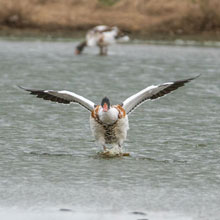 |
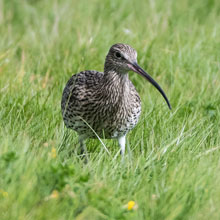 |
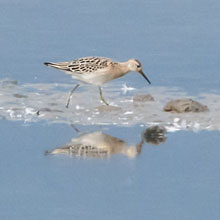 |
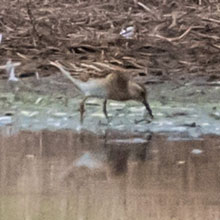 |
Fairly pleased and slightly damp, we moved back down to the sea wall to see
if we could make out the American White-winged Scoter within the flock of
regular Velvet Scoters. Initially we could not as they were too far out and the
light was pretty gloomy. We did though get a visit from a Guillemot that popped
up in the sea just below the sea wall. A Great Black-backed Gull cruised past,
and then a Cormorant surfaced just in front of us. The light improved and the
Scoters, about 40 of them, got a bit closer but we couldn’t see the one we were
after. On inspecting the pictures later that night I saw a few that might have
shown it, but I remain unconvinced.
As we struggled back to the car to drive to the Esk mouth, we were startled
by a Pheasant that flew over the Scrapes fence, itself obviously startled by
something. I managed a couple of shots before it disappeared into the long
grass. At the Esk we parked next to the Cadet Hall and looked upstream for
signs of a reported Kingfisher. Sure enough, John spotted it taking a fish from
the water up to a rung of a ladder on the riverbank. We watched it for about a
quarter of an hour during which time I got some nice shots, some as it flew
along the bank.
Our final foray at Musselburgh was a quick look at the mouth of the river.
Of course, there were the ever-present Oystercatchers and Curlew, but I love to
watch them and I’m always looking for interesting shots like the Curlew
dispatching a couple of small Crabs (see below and Pictures of the Week). On
our way back to the car John pointed out our first sighting for a few months of
a Wigeon as it dabbled along the river shallows. It was John again who noticed
a Kestrel hunting in its unique hovering style along the banks of the estuary
hinterland. It was a pity the light was very poor, but the photo below shows
the bird in action.
| Oystercatcher |
Curlew |
Wigeon |
Kestrel |
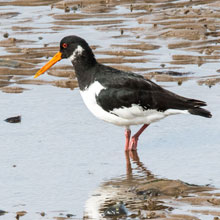 |
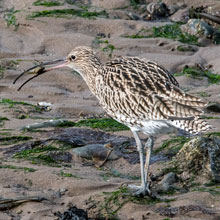 |
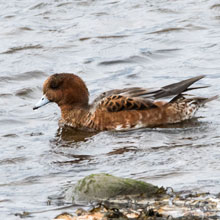 |
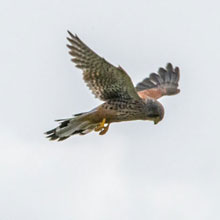 |
We got our tea and lemon cream muffins from the car and sat at the side of
the Esk eating, drinking and watching for any further action from the
Kingfisher. No such luck, but it didn’t matter as we were happy enough with our
haul of pictures. Still, I might return soon to catch up with the birds we
missed.
Pictures of the week
| Common Seal |
1st Cycle Gannet |
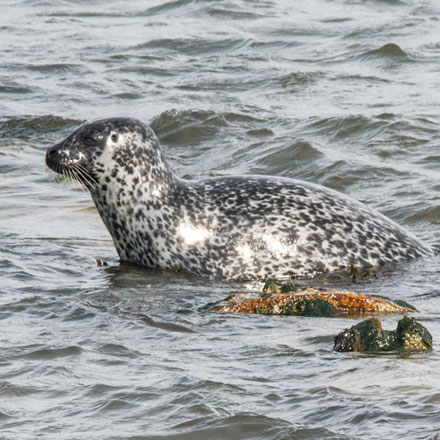 |
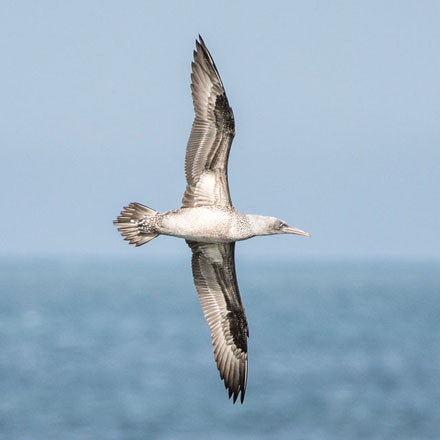 |
| Kingfisher |
Curlew |
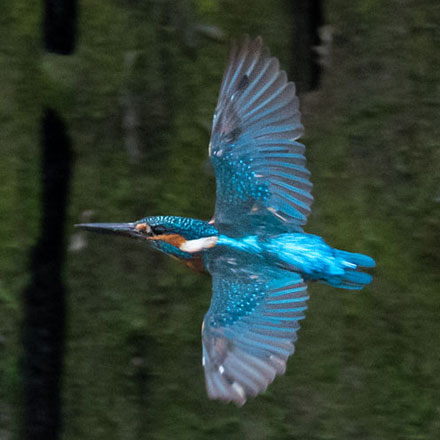 |
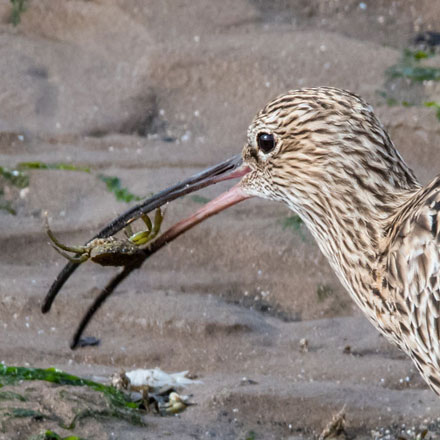 |
Friday 4th and 7th September 2018:
RSPB Baron’s Haugh, Motherwell
This is a record of a couple of fairly brief visits to my local reserve at
RSPB Baron’s Haugh, Motherwell. Poor John was working so I was on my own. The
weather both days was very bright and mild, ideal for photographing nature.
Tuesday 4th September:
It was a quiet walk from the car to the reserve hides. There was hardly a
twitter, not even a crow or pigeon. However when I arrived at the Causeway
Hide, birders there drew my attention to a Water Rail that was lurking in the
reeds just below the hide. Before long it emerged into the pools and we all had
great opportunities for shots before it scampered back into the reedbed. As I
waited for it to re-emerge, I noticed the foliage close to the hide was moving
erratically as if something was rummaging below. Then suddenly, it became
apparent that it was a fledgling Wren climbing up the vegetation. It was lucky
there wasn’t a Sparrowhawk about as it looked very weak and vulnerable. Out on
the Haugh, as well as the usual Mallards, I could see a few Black-tailed
Godwits, some resting, some preening and others feeding. There was a large
flock of Lapwings on the opposite side, but the occasional individual checked
out the end I was on.
| Water Rail |
Juvenile Wren |
Black - tailed Godwit |
Lapwing |
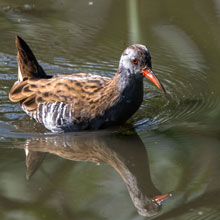 |
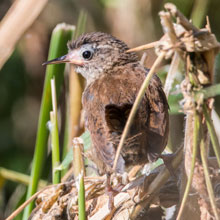 |
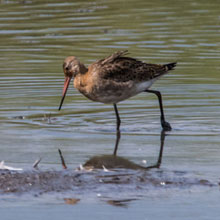 |
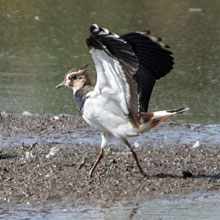 |
A wee Green Sandpiper also flew past the hide, but didn’t fancy it and kept
flying before settling on a sandy bank some 60 m away. That was one of about a
dozen that had been seen there in the previous few weeks. And with the beeping
of a text message from the wife, that was that for my Tuesday visit.
Thursday 7th September:
My Thursday walk down to the Causeway Hide was a only a bit more productive.
A well-lit Magpie sat on a treetop calling to others on trees further down. It
was a bit more vacant Haugh when I arrived at the hide than from the Tuesday.
Some Snipe gathered around an exposed tree stump was the only sighting close
enough for decent shot, but further away I also spotted Curlew, Little Grebes,
Green Sandpipers, Cormorants, Grey Heron and, of course, Mallards. I decided to
go for a walk around the reserve to see if I could see anything on the River
Clyde, and to heat myself up as there was a steady, chilling breeze blowing
through the hide. As I sat on a bench by a bend on the River Clyde where Otters
frequently turn up, I was startled by a lone Bar-tailed Godwit darting fairly
erratically over the River. I wondered where its mates were. I must have missed
them.
| Green Sandpiper |
Magpie |
Common Snipe |
Bar - tailed Godwit |
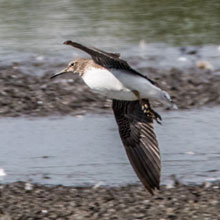 |
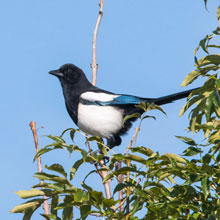 |
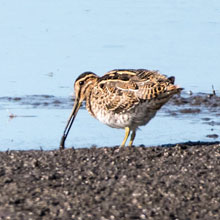 |
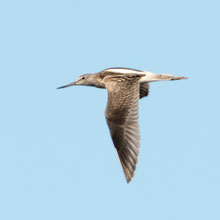 |
Next I thought I saw a Mallard paddling close by on the Clyde, but on
noticing it’s long bill I think it is a hybrid, possibly with some Shoveler in
it. Then, slightly disappointed that the Otter didn’t turn up, I stood up to
move on, only to stop when I heard a calling Buzzard circling directly
overhead. I got some excellent shots of the back-lit bird against the azure
sky. On my way back to the Causeway Hide I came upon another Magpie, this time
it was much closer sitting on branches overlooking a field.
I returned satisfied to the Causeway Hide and then got a few more pleasing
shots. First was of Snipe that were happily prodding the shallows for
invertebrates, but were spooked by something or other, probably a passing
raptor. They fled southwards to find safety. In the middle of the Haugh, I
could hear the persistent calls of a Great Crested Grebe chick. One of its
parents surfaced with a fish in its beak, paddled towards the chick, who was
delighted to receive it. A birder later informed me that there were two chicks
and that each was being fed by one of its parents. My last photo from the
Causeway Hide was of a group of about six Little Grebes “charging” across the
water surface, for what precise reason, I’m not sure. On my way back to my car,
I popped into the Marsh Hide but all I observed was a passing Grey Heron.
| Common Snipe |
Great Crested Grebe |
Little Grebe |
Grey Heron |
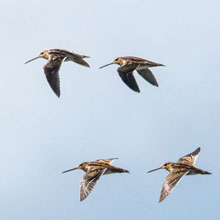 |
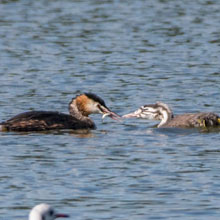 |
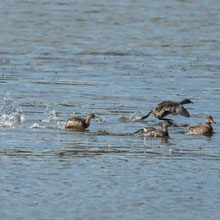 |
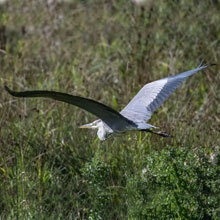 |
As can be seen from the pictures I’ve assembled, RSPB Baron’s Haugh is an
excellent reserve for observing wildlife. Also it is worth noting, stating the
obvious, that repeated short visits over a few days bring rewards. Finally, I’d
like to say that walking a reserve is a therapeutic experience that dissolves
away some of life’s worries (but only if you don’t run into one of the, sadly,
increasing number of professional dog walkers whose antics tend to raise the
blood pressure).
Pictures of the Week:
| Water Rail |
Juvenile Wren |
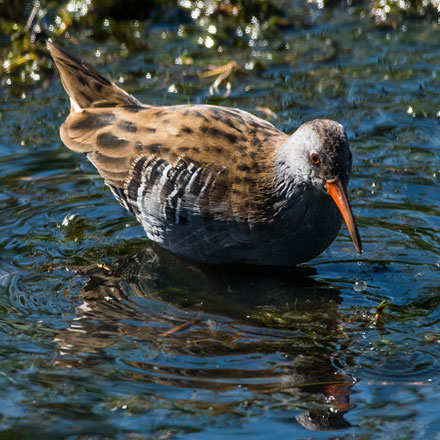 |
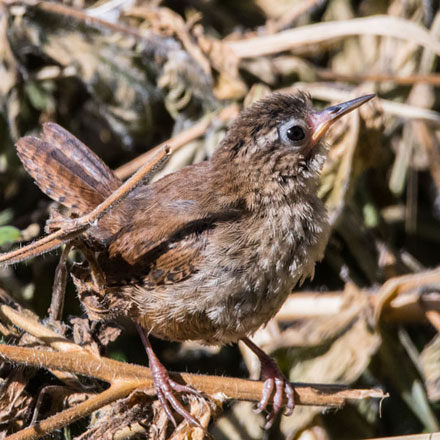 |
| Common Snipe |
Common Buzzard |
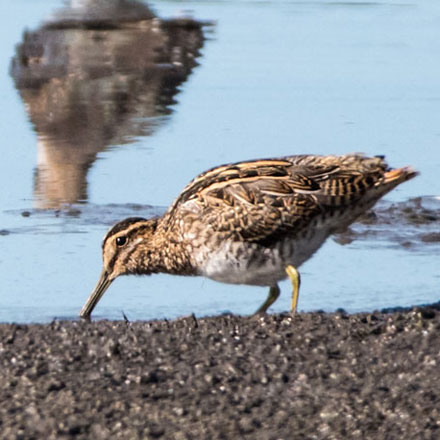 |
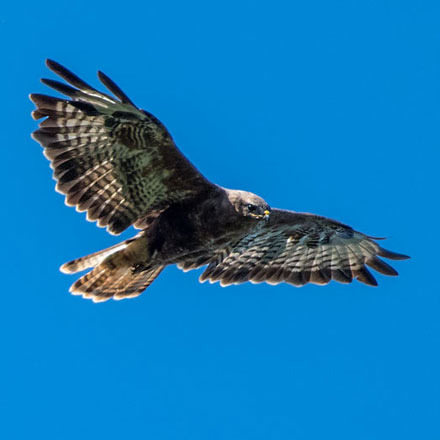 |
2nd September 2018: Aberlady (Kilspindie)
The weather predictions for Sunday were directing us to the east. Rain was
threatened in the west, while the east was to have been dry but, alas,
overcast. In Twitter feeds, birders had flagged up encouraging sightings around
Aberlady LNR, including Little Egrets, Short-eared Owl, Black-tailed Godwits
and Peregrine. So Aberlady it was. First stop was, of course, breakfast at
Dalkeith Morrisons (9/10: -1 for John’s over-greasy eggs). At Aberlady, the
small LNR car park was full, but we managed to park a 1/2 mile back, at the
edge of the town. We decided instead to explore the shore to the north of the
town beside the Kilspindie Golf Club. This was new ground for each of us. The light was very poor as we set off along the damp, marshy edges of the
shore, but we immediately were greeted by a trio of beautiful butterflies.
First a quite lively Small White settled on a flower of the plentiful
violet-tinged Sea Aster. Next a few Painted Ladies appeared and eventually one
rested on a wee sandy patch, giving me enough time to capture a few shots. Much
less flighty than these was a large Peacock butterfly. I was able to get quite
a few nice macro shots on my trusty Panasonic Lumix LX5, although the light
level was still depressingly dull.
| Small White Butterfly |
Painted Lady Butterfly |
Peacock Butterfly |
Sea Aster |
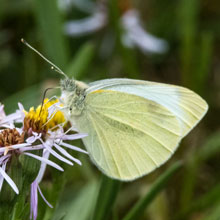 |
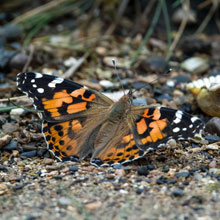 |
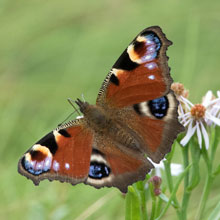 |
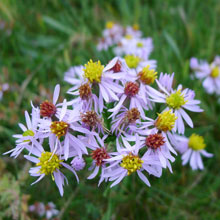 |
There were a few other insects frequenting the salt marsh. Honey Bees looked
busy as they systematically moved from daisy to daisy. Also working the flowers
were several species of hoverflies. The Common Banded hoverfly, Syrphus
Ribesii, was largest amongst these with prominent yellow and black banded
abdomen and gold-topped thorax. I must admit I’ve a soft spot for the UK’s most
common hoverfly, the small Marmalade. Its orange-tinged abdomen are
marmalade-coloured - hence the name. Less attractive though was my next
capture, a spider. I’ve yet to firmly identify it, but it may be the Common
Garden spider.
| Honey Bee |
Hoverfly - Syrphus ribesii |
Marmalade Hoverfly |
Common Garden Spider |
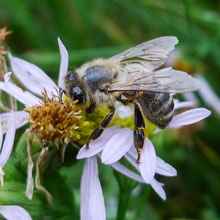 |
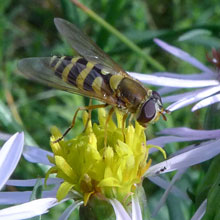 |
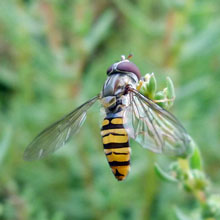 |
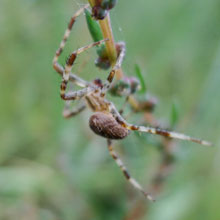 |
As we trudged on towards Aberlady Point we could see that the sun was
shining on the Kingdom of Fife, Methil, to be specific, where a huge wind
turbine is currently stationed
. We hoped the sun would soon also bless us with its presence. Some incoming
Oystercatchers caught my attention just as we passed the Kilspindie Golf Club
flag post. A Mallard retreated into the gloom, unimpressed by our attention.
| Methil |
Kilspindie Golf Club |
Oystercatcher |
Mallard |
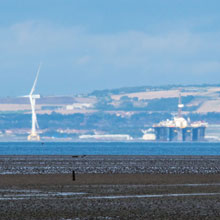 |
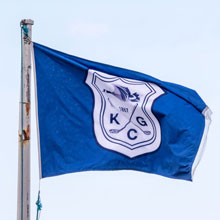 |
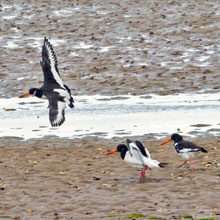 |
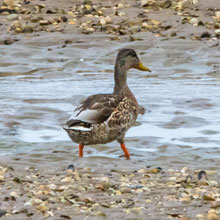 |
At the Point, at the edges of the shore, a pair of fledgling Swallows were
being fed by a nervous parent. The young birds were perched on big rocks,
waiting for the adult bird to return with insects.Nearer the sea, a Bar-tailed
Godwit and a Curlew were passing each other without taking any notice of each
other, probably because they don’t eat the same food. Then our prayers were
answered - the sun came out from behind the clouds! A female Wheatear whizzed
passed away to the top of a rock. Notice, from the picture, it’s white rump,
from which its name derives- “white erse” became “wheatear”.
We then came upon an area of shore from which the sea had recently receded.
Foraging about the damp rocks and pools were Dunlins and Ringed Plovers. Their
sunlit plumages were stunning. I planted myself behind a large rock just low
enough to allow me to shoot pictures without distracting the birds. The sun was
behind us - a good tip for new birders. If you stay still with sun behind,
preferably seated, the birds see you in silhouette and don’t recognise you as
being human. As if to prove this, a male Linnet flew over the Ringed Plover and
straight towards us, and seeing us at the last second, landed on a rock to our
right. I then took a few shots of a lovely grey and white juvenile Ringed
Plover. It’s a fact that most juveniles don’t survive past their 1st year, but
those that do may live up to 10 years.
| Dunlin |
Ringed Plover |
Linnet |
Juvenile Ringed Plover |
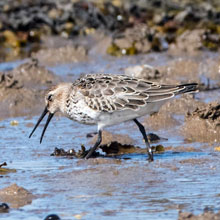 |
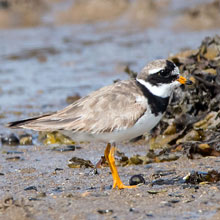 |
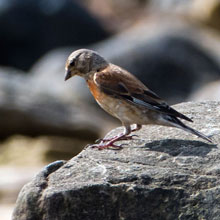 |
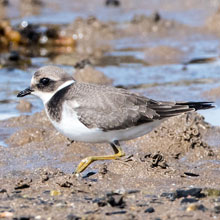 |
We set off back to the car, retracing our steps, but in much better light. A
well-illuminated female Wheatear stood boldly on a boulder until we got within
its “safe distance” when it retreated to another. Then, much to our delight, I
spotted a Little Egret walking along the Peffer Burn. This very attractive
species is a relative newcomer to Scotland, having spread to the UK from the
continent as recently as 1989
. To get a better shot, I carefully moved out over the shore towards it,. I had
a 600mm lens, so I didn’t need to get too close, and avoided disturbing it. We
passed another historic feature, the old Custom house
I noticed a white Sea Aster amid the usual violet ones. We moved off the
shore onto the road into the golf club. We were watched by a bird on a wire. At
first I thought it was a Sparrow, but I think it looks like a sick Linnet. A
pair of Mute Swans powered along the sands just as we reached the car. We moved
west to Port Seton where we were met by a Pied Wagtail. But that was it for the
day.
| Sea Aster |
Linnet |
Mute Swan |
Pied Wagtail |
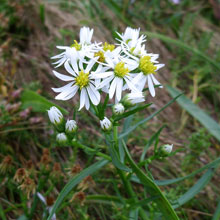 |
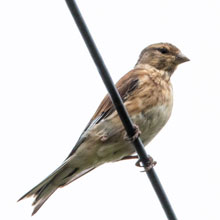 |
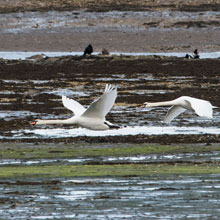 |
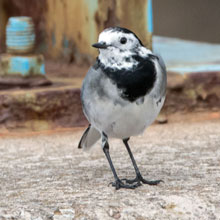 |
Our trip was an exercise in positive thinking. Things turned out much better
than I first thought they might. Main highlight of the day, that had many
highlights, was the Little Egret. We celebrated with a Danish Pastry and a cup
of strong tea.
Pictures of the Week:
| Peacock Butterfly |
Female Wheatear |
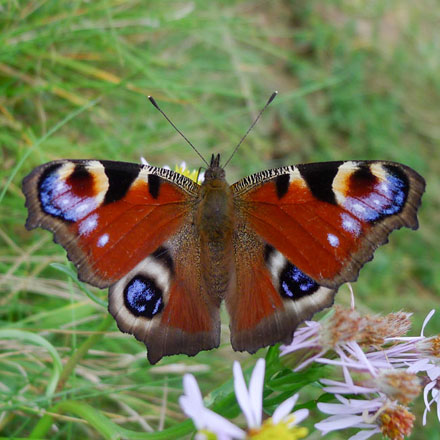 |
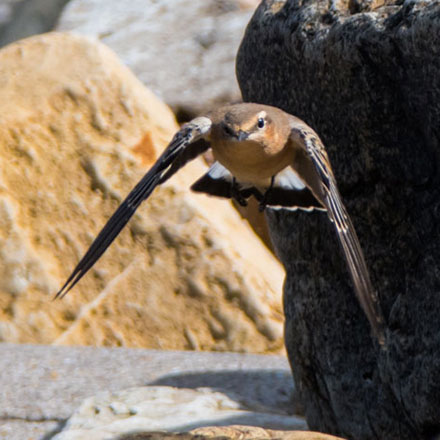 |
| Dunlin / Ringed Plover |
Little Egret |
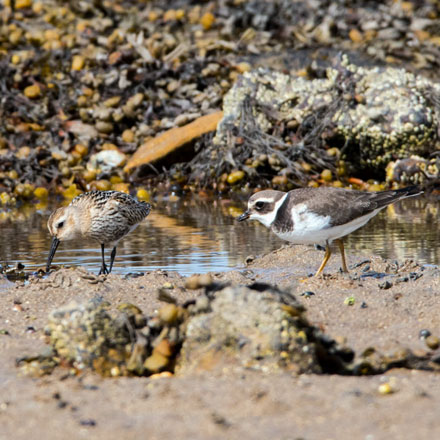 |
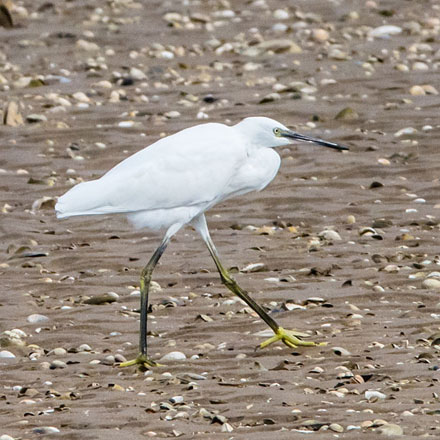 |
Back To Top
|

